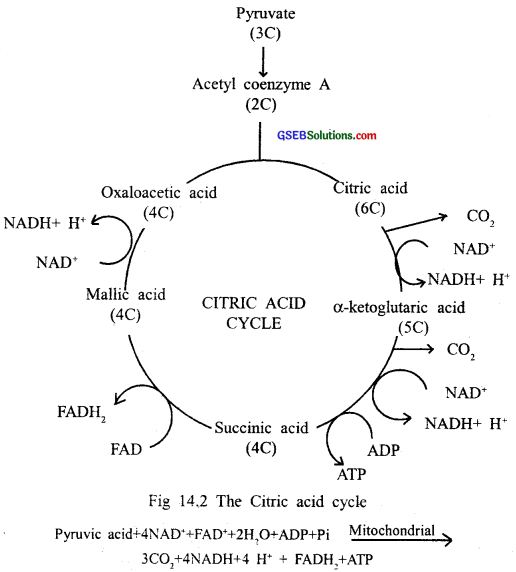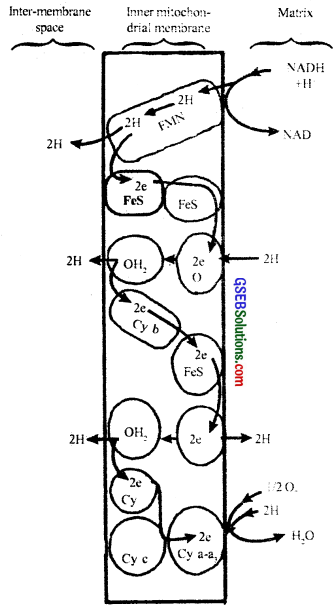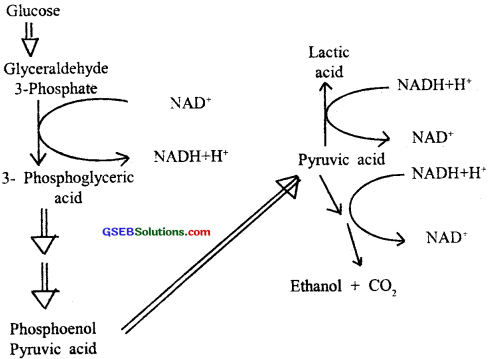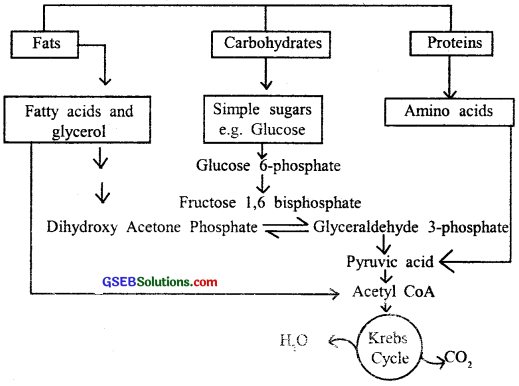Gujarat Board GSEB Textbook Solutions Class 11 Biology Chapter 14 Respiration in Plants Textbook Questions and Answers.
Gujarat Board Textbook Solutions Class 11 Biology Chapter 14 Respiration in Plants
GSEB Class 11 Biology Respiration in Plants Text Book Questions and Answers
Question 1.
Differentiate between
- Respiration and combustion
- Glycolysis and Krebs cycle
- Aerobic respiration & Fermentation
Answer:
(1) Differences between respiration and combustion:
Respiration:
The breaking of the C-C bonds of complex compounds through oxidation within the cells, leading to the release of a considerable amount of energy is called respiration.
- It is a controlled biochemical process
- Many chemical bonds break simultaneously by releasing a large amount of energy at a time. Energy is not stored in it. No ATP is formed.
- No intermediates are produced.
- Temperature goes very high in it.
- No enzymes are involved.
Combustion:
The complete combustion of glucose, which produces CO2, and H2O as end products, yields energy most of which is given out as heat. If this energy is to be useful to the cell, it should be able to utilize to synthesis other molecules that the cell requires.
- It is an uncontrolled Physico-chemical process.
- In this chemical bonds break one after the other to release energy gradually which is stored in ATP molecules.
- A large number of intermediates are produced.
- It occurs at a specific temperature only.
- Enzymes are used at each and every step of respiration.
(2) Differences between glycolysis and Krebs cycle:
Glycolysis:
Some of these organisms are facultative anaerobes, while in others the requirement for the anaerobic condition is obligate. In any case, all living organisms retain the enzymatic machinery to partially oxidize glucose without the help of oxygen. This breakdown of glucose to pyruvic acid is called glycolysis.
Krebs cycle:
Pyruvic acid is then the key product of glycolysis. This depends on the cellular need. There are three major ways in which different cells handle pyruvic acid produced by glycolysis. These are lactic acid fermentation, alcoholic fermentation, and aerobic respiration. Fermentation takes place under anaerobic conditions in many prokaryotes and unicellular eukaryotes. For the complete oxidation of glucose to CO2 and H2O. however, organisms adapt Kerb’s cycle which is also called aerobic respiration. This requires an O2 supply.
(3) Differences between aerobic respiration and fermentation:
Aerobic respiration:
Aerobic respiration is the process that leads to the complete oxidation of organic substances in the presence of oxygen and releases CO2 water and a large amount of energy present in the substrate. This type of respiration is the most common in higher organisms. The crucial events in aerobic respiration are:
- The complete oxidation of pyruvate by the stepwise removal of all the hydrogen atoms, leaving three molecules of CO2
- The passing on of the electrons removed as part of the hydrogen atoms to molecular O2 with the simultaneous synthesis of ATP.
Fermentation:
In fermentation, say by yeast, the incomplete oxidation of glucose is achieved under anaerobic conditions by sets of reactions where pyruvic acid is converted to CO2 and ethanol. The enzymes, pyruvic acid decarboxylase, and alcohol dehydrogenase catalyze these reactions.
Other organisms like some bacteria produce lactic acid from pyruvic acid. In animal cells also, like muscles during exercise, when oxygen is inadequate for cellular respiration pyruvic acid is reduced to lactic acid by lactate dehydrogenase. The reducing agent is NADH + H+ which is oxidized to NAD+ in both processes.
![]()
Question 2.
What are respiratory substrates? Name the most common respiratory substrate.
Answer:
The compounds oxidized during the process of respiration are called respiratory substrates. Carbohydrates especially glucose act as respiratory substrates. Fats, proteins, and organic acids also act as respiratory substrates.
Question 3.
Give the schematic representation of glycolysis?
Answer:
The scheme of glycolysis was given by Gustav Embden, Otto Meyerhof, and J. Pamas, and is often referred to as the EMP pathway. In anaerobic organisms, it is the only process in respiration. Glycolysis occurs in the cytoplasm of the cells and is present in all living organisms. In this process, glucose undergoes partial oxidation to form two molecules of pyruvic acid. In plants, this glucose is derived from sucrose, which is the end product of photosynthesis, or from storage carbohydrates. Sucrose is converted into glucose and fructose by the enzyme invertase, and these two monosaccharides can readily enter the glycolytic pathway.
Glucose and fructose are phosphorylated to give rise to glucose -6- phosphate by the activity of the enzyme hexokinase. This phosphorylated form of glucose then isomerizes to produce fructose -6- phosphate. Subsequent steps of the metabolism of glucose and fructose are the same. In glycolysis, a chain of ten reactions, under the control of different enzymes, take place to produce pyruvate from glucose. While studying the steps of glycolysis, please note the steps at which utilization (ATP energy) or synthesis of ATP or (in this case of) NADH + H+ take place.
ATP is utilized at two steps: first in the conversion of glucose into glucose 6- phosphate and second in the conversion of fructose 6- phosphate to fructose 1-6-diphosphate.

The fructose 1 -6- diphosphate is split into dihydroxyacetone and 3-phosphoglyceraldehyde (PGAL). We find that there is one step where NADH + H+ is formed from NAD+; this is when 3-phosphoglyceraldehyde (PGAL) is converted to 1,3-bisphosphoglycerate (DPGA). The conversion of DPGA to 3-phosphoglyceric acid (PGA), is also an energy-yielding process; this energy is trapped by the formation of ATP. Another ATP is synthesized during the conversion of PEP to pyruvic acid. Pyruvic acid is then the key product of glycolysis. This depends on the cellular need. There are three major ways in which different cells handle pyruvic acid produced by glycolysis. These are lactic acid fermentation, alcoholic fermentation, and aerobic respiration. Fermentation takes place under anaerobic conditions in many prokaryotes and unicellular eukaryotes.
![]()
Question 4.
What are the main steps in aerobic respiration? Where does it take place?
Answer:
For aerobic respiration to take place within the mitochondria, the final product of glycolysis, pyruvate is transported from the cytoplasm into the mitochondria. The crucial events in aerobic respiration are;
- The complete oxidation of pyruvate by the stepwise removal of all the hydrogen atoms, leaving three molecules of CO2.
- The passing on of the electrons removed as part of the hydrogen atoms to molecular O2 with the simultaneous synthesis of ATP.
The first of these processes take place in the matrix of the mitochondria while the second process is located on the inner membrane of the mitochondrial.
Pyruvate, which is formed by the glycolytic catabolism of carbohydrates in the cytosol, after it enters the mitochondrial matrix undergoes oxidative decarboxylation by a complex set of reactions catalyzed by pyruvic dehydrogenase. The reactions catalyzed by pyruvic dehydrogenase require the

During this process, two molecules of NADH are produced from the metabolism of two molecules of pyruvic acid (produced from one glucose molecule during glycolysis).

![]()
Question 5.
Give the schematic representation of an overall view of Kreb’s cycle.
Answer:
Tricarboxylic acid cycle, more commonly called as Krebs cycle after the scientist Hans Krebs who first elucidated it. The TCA cycle starts with the condensation of the acetyl group with oxaloacetic acid (OAA) and water to yield citric acid. The reaction is catalyzed by the enzyme citrate synthase and a molecule of CoA is released. Citrate is then isomerized to Jsocitrate. It is followed by two successive steps of decarboxylation, leading to the formation of an acid and then succinyl – CoA. In the remaining steps of the citric acid cycle, succinyl – CoA is oxidized to OAA allowing the cycle to continue. During the conversion of succinyl.
CoA to succinic acid a molecule of.GTP is synthesized. This is substrate-level phosphorylation. In a coupled reaction GTP is converted to GDP with the simultaneous synthesis of ATP from ADP. Also, there are three points in the cycle where NAD+ is reduced to NADH + H+ and one point where FAD4 is reduced to FADH2 The continued oxidation of acetic acid via the TCA cycle requires the continued replenishment of oxaloacetic acid, the first member of the cycle. In addition, it also requires regeneration of NAD+ and FAD from NADH and FADH, respectively. The summary equation for this phase of respiration may be written as follows:

Question 6.
Explain ETS.
Answer:
The metabolic pathway through which the electron passes from one carrier to another is called the electron transport system (ETS) and it is present in the image mitochondrial membrane. Electrons from NADH produced in the mitochondrial matrix during the citric acid cycle are oxidized by an NADH dehydrogenase (Complex I), and electrons are then transferred to ubiquinone located within the inner membrane. Ubiquinone also receives reducing equivalents via FADH2 (Complex II) that is generated dining oxidation of succinate in the citric acid cycle.
The reduced Ubiquinone (Ubiquinol) is then oxidized with the transfer of electrons to cytochrome C via cytochrome bc1 complex (Complex III). Cyt nichrome c is a small protein attached to the outer surface of the inner membrane and acts as a mobile carrier for the transfer of electrons between complex III and IV. Complex IV refers to cytochromes a and a3, and two copper centers.
When the electrons pass from one carrier to another via complex I to IV in the electron transport chain, they are coupled to ATP synthase (Complex V) for the production of ATP from ADP and inorganic phosphate. The number of ATP molecules synthesized depends on the nature of the electron donor. Oxidation of one molecule of NADH gives rise to 3 molecules of ATP, while that of one molecule of FADH2 produces 2 molecules of ATP. Although the aerobic process of respiration takes place only in the presence of oxygen, the role of oxygen is limited to the terminal stage of the process.

![]()
Question 7.
Distinguish between the following:
- Aerobic respiration and Anaerobic respiration
- Glycolysis and Fermentation
- Glycolysis and Citric acid Cycle.
Answer:
(1) Differences between Aerobic respiration and anaerobic respiration:
Aerobic respiration:
- It occurs in the presence of molecular oxygen.
- It always produces CO2
- It produces water.
- It occurs in the cytoplasm and mitochondria of cells.
- It produces a large amount of energy.
- Glucose is completely oxidized to water.
- It occurs in most of the plants and animals cells except yeasts, certain bacteria, endoparasitic worms, skeletal muscles arid mammalian RBCs
Anaerobic respiration:
- It occurs in the absence of oxygen.
- It may or may not produce CO2
- It does not produce water.
- It occurs only in the cytoplasm and outside the mitochondria of cells
- It produces a very less amount of energy.
- Glucose is incompletely metabolized into CO2 and into ethyl alcohol or lactic acid.
- It occurs-only in yeasts, certain bacteria, endoparasitic worms, skeletal muscles, and mammalian RBCs.

(2) Differences between glycolysis and fermentation:
Glycolysis:
- Glycolysis occurs in the cytoplasm of the cell and is present in all living organisms.
- In this process, glucose undergoes partial oxidation to form two molecules of pyruvic acid.
- In plants, this glucose is derived from sucrose, which is the end product of photosynthesis, or from storage carbohydrates.
- Sucrose is converted into glucose and fructose by the enzyme invertase, and these two monosaccharides can readily enter the glycolytic pathway.
- Glucose and Fructose are phosphorylated to give rise to glucose -6- phosphate by the activity of the enzyme hexokinase.
Citric acid cycle:
- The reaction is catalyzed by the enzyme citrate synthase and a molecule of CoA is released.
- Citrate is then isomerized to isocitrate. It is followed by two successive steps of decarboxylation, leading to the formation of a- ketoglutaric acid and then succinyl -CoA.
- In both lactic acid and alcohol fermentation, not much energy is released less than seven percent of the energy in glucose is released and not all of it is trapped as high energy bonds of ATP. Also, the processes are hazardous-either acid or alcohol is produced.
- Yeasts poison themselves to death when the concentration of alcohol reaches about 13 percent.
- In eukaryotes, these steps take place within the mitochondria and this requires O2
(3) Differences between glycolysis and citric acid cycle:
Glycolysis:
- Glycolysis occurs in the cytoplasm of the cell and is present in all living organisms.
- In this process, glucose under-goes partial oxidation to form two molecules of pyruvic acid.
- In plants, this glucose is derived from sucrose, which is the end product of photosynthesis, or from storage carbohydrates.
- Sucrose is converted into glucose and fructose by the enzyme invertase, and these two monosaccharides can readily enter the glycolytic pathway.
- Glucose and Fructose are phosphorylated to give rise to glucose -6- phosphate by the activity of the enzyme hexokinase.
- This phosphorylated form of glucose then isomerizes to produce fructose -6- phosphate.
- Subsequent steps of the metabolism of glucose and fructose are the same.
- In glycolysis, a chain of ten reactions, under the control of different enzymes, take place to produce pyruvate from glucose.
- ATP is utilized at two steps: first in the conversion of glucose into glucose 6- phosphate and second in the conversion of fructose 6- phosphate to fructose 1.6-diphosphate.
- The fructose 1,6-diphosphate is split into dihydroxyacetone phosphate and 3-phosphoryl acetaldehyde (PGAL). PGAL is oxidized and with inorganic phosphate to get converted into DPGA.
- The conversion of DPGA to 3-phosphoglyceric acid (PGA), is 3. The remaining steps of citric also an energy-yielding process; this energy is trapped by the formation of ATP. Another ATP is synthesized during the conversion of PEP to pyruvic acid.
- Pyruvic acid is then the key product of glycolysis.
Citric acid cycle:
- The reaction is catalyzed by the enzyme citrate synthase and a molecule of CoA is oxidized to OAA allowing the cycle to continue.
- Citrate is them isomerizes to isocitrate. it is followed by two successive steps of decarboxylation, leading to the formation of α-ketoglutaric acid and succinyl -CoA.
- In the remaining steps of the citric acid cycle, succinyl-CoA is oxidized to OAA allowing the cycle to continue.
- During the conversion of succinyl-CoA to succinic acid, a molecule of GTP is synthesized. This is substrate-level phosphorylation.
- In a coupled reaction GTP is converted to GDP with the simultaneous synthesis of ATP from ADP.
- Also, there are three points in the cycle where NAD+ is reduced to NADH+H4 and one point where FAD+ is reduced to FADH2.
- The continued oxidation of acetic acid via the TCA cycle requires the continued replenishment of oxaloacetic acid, the first member of the cycle.
- In addition, it also requires regeneration of NAD+ and FAD from NADH and FADH2 respectively.
![]()
Question 8.
What are the assumptions made during the calculation of the net gain of ATP?
Answer:

It is possible to make calculations of the net gain of ATP for every glucose molecule oxidized, but in reality, this can remain only a theoretical exercise. These calculations can be made only on certain assumptions that:
- It is assumed that various parts of aerobic respiration such as glycolysis, TCA cycle and ETS occur in a sequential and orderly pathway.
- NADH produced during the process of glycolysis enters into mitochondria to undergo oxidative phosphorylation.
- Glucose molecule is assumed to be the only substrate while it is assumed that no other molecule enters the pathway at intermediate stages.
- The intermediates produced during respiration are not utilized in any other process.
But these kind of assumptions are not really valid in a living system;
ail pathway works simultaneously and does not take place one after another; substrates enter the pathways and are withdrawn from it as and when necessary; ATP is utilized as and when needed; enzymatic rates are controlled by multiple means. Yet, it is useful to do this exercise to appreciate the beauty and efficiency of the living system in the extraction and storing of energy. Hence, there can be a net gain of 36 ATP molecules during aerobic respiration of one molecule of glucose.
Question 9.
Discuss “The respiratory pathway is an amphibolic pathway”.
Answer:
Glucose is the favored substrate for respiration. All carbohydrates are usually first converted into glucose before they are used for respiration. Other substrates can also be respired, as has been mentioned earlier, but then they do not enter the respiratory pathway at the first step. Fats would need to be broken down into glycerol and fatty acids first. If fatty acids were to be respired they would first be degraded to acetyl CoA and enter the pathway. Glycerol would enter the pathway after being converted to PGAL. The proteins would be degraded by proteases and the individual amino acids (after deamination) depending on other structures would enter the pathway at some stage within the Krebs, cycle or even as pyruvate or acetyl CoA.

Since respiration involves the breakdown of substrates, the respiratory process has traditionally been considered a catabolic process, and the respiratory pathway is a catabolic pathway. Hence, fatty acids would be broken down to acetyl CoA before entering the respiratory pathway when it is used as a substrate. But when the organism needs to synthesize fatty acids, acetyl CoA would be withdrawn from the respiratory pathway for it. Hence the respiratory pathway comes into the picture both during the breakdown and synthesis of fatty acids. Similarly, during the breakdown and synthesis of protein too, respiratory intermediates form the link. Breaking down processes within the living organism is catabolism, and synthesis is anabolism. Because the respiratory pathway is involved in both anabolism and catabolism, it would hence be better to consider the respiratory pathway as an amphibolic pathway rather than as a catabolic one.
![]()
Question 10.
Define RQ. What is its value for fats?
Answer:
As we know, during aerobic respiration, O2 is consumed and CO2 is released. The ratio of the volume of CO2 evolved to the volume of O2 consumed in respiration is called the respiratory quotient (RQ) or respiratory ratio.

The respiratory quotient depends upon the type of respiratory substrate used during respiration.
When carbohydrates are used as substrate and are completely oxidized the RQ will be 1, because equal amounts of CO2 and O2 are evolved and consumed, respectively, as shown in the equation below :

When fats are used in respiration, the RQ is less than 1. Calculations for fatty acid, tripalmitin, if used as a substrate is shown:

When proteins are respiratory substrates the ratio would be about 0.9
Question 11.
What is oxidative phosphorylation?
Answer:
Oxidative phosphorylation is a process in which electrons are transferred from electron donors to oxygen which acts as the electron acceptor. The oxidation-reduction reactions are involved in the formation of a proton gradient. The main role in oxidative phosphorylation is played by the enzyme ATP synthase. This enzyme complex consists of F0 and F1, components. For every two protons passing through F0-F1, complex, synthesis of one ATP molecule takes place.
![]()
Question 12.
What is the significance of the step-wise release of energy in respiration?
Answer:
The process of aerobic respiration is divided into four phases glycolysis, TCA cycle, ETS, and oxidative phosphorylation. It is generally assumed that the process of respiration and production of ATP in each phase takes place in a step-wise manner.
The product of one pathway forms the substrate of the other pathway. Various molecules produced during respiration are involved in other biochemical processes. The respiratory substrates enter and withdraw from the pathway on necessity. Thus, the stepwise release of energy makes the system more efficient in extracting and storing energy.